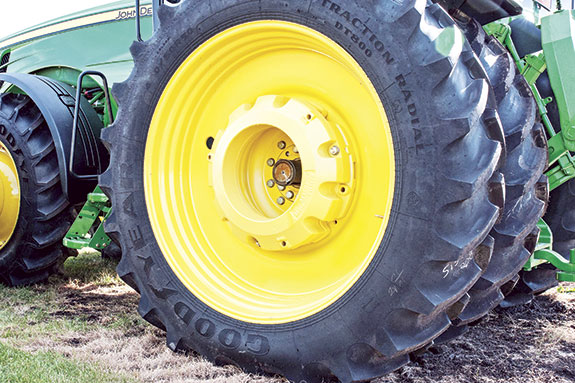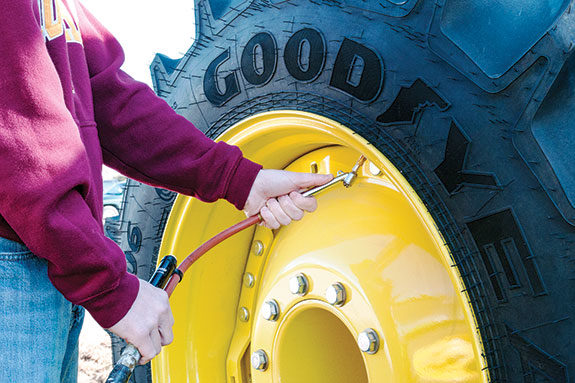Obtaining optimum performance from your tractor tires requires one of your most valuable resources: time. But the time spent checking inflation pressures and adjusting tractor ballast can pay big dividends in terms of improved traction, decreased compaction and better overall performance.
Air carries the load
Air pressure is the most critical part of the equation because air – not the tire itself – carries the load of the tractor and the implement.
The best thing farmers can do is determine the load they will be carrying for various applications (chisel disk, planter, etc.), and adjust the inflation pressures accordingly.
Determining the weight load of your tractor and implement can be as simple as visiting a local retailer with a scale.
It’s important, however, that any additional weights are in place and all tanks (both fuel and saddle) are full when being weighed.
If no scale is available, work with your local tire dealer to help calculate the overall weight. Once you’ve determined the load, it’s time to adjust the inflation pressures.
The Tire and Rim Association of America (TRA), made up of all major tractor tire manufacturers, has established a set of recommendations for setting inflation pressures based on load. These tables can be accessed on tire manufacturers’ websites or by contacting your local tire dealer.
Not only will adjusting inflation pressures result in better productivity and fuel efficiency, but it can also affect the ride and handling in both the field and on the road. There are some compromises, however.
The optimum inflation pressure for fieldwork may not produce a smooth ride when moving from one field to the next.
A farmer can always take time to increase inflation pressure when driving between fields and then drop the pressures back down before commencing additional fieldwork.

Don’t ignore ballast
Ballast is another way to maximize performance in the field by enhancing traction.
By enhancing traction, fuel efficiency can be improved, and issues such as power hop can be remedied.
Power hop occurs when the tractor tires load up and let loose, causing the tractor to jump in a high-torque application.
To enhance traction, additional weight can be added to the front or rear wheels.
Ballast should be used to attain enough traction to pass power to the ground without creating excessive wheel slip.
Too much ballast can create a deeper track, which can result in power loss. Before making a decision on ballast, farmers should also take into consideration the type of implement being used. The heavier the implement, the more traction you get.
The balancing act
The lower your tire inflation pressure, the less ballast needed, and the higher your inflation pressure, the more weight needed to get the same traction. So it’s all about finding the right balance.
Take some time to care for your tires, and you may be surprised at the results you attain in the field.
By adjusting inflation pressures and ballast, you will see better traction, less compaction and improved fuel efficiency. Over the course of a growing season, these small adjustments can help save time and money in the long term. PD

Scott Sloan
Ag Products Manager
Titan Tire Corporation






